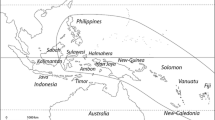Abstract
The Weed-Broomcorn Millet,Panicum miliaceum L. subsp.ruderale (Kitag.)Tzvelev, until now observed only in Asiatic countries, is also present in Austria (C. Europe). Whereas the cultivatedP. miliaceum subsp.miliaceum, devoid of all natural dispersal ability, cannot actively spread, the Weed-Broomcorn Millet can do so successfully and is increasingly infesting fields ofZea mays. Its spikelets disarticulate at maturity below the glumes, and moreover the florets disarticulate above the sterile floret by means of an abscission layer just beneath a swelling body which developes from the upper rachilla segment. All facts and findings are in favour of the assumption that the Weed-Broomcorn Millet is a product of repeated reverse mutations inP. miliaceum subsp.miliaceum.
Similar content being viewed by others
Literatur
Behrens, R., 1979: Weed control in US maize. — InHäfliger, E., (Ed.): Maize. CIBA-GEIGY Agrochemicals, Technical Monograph, pp. 38–45. — Basel: CIBA-GEIGY.
Bertsch, K. & F., 1949: Geschichte unserer Kulturpflanzen. — Stuttgart: Wissenschaftliche Verlagsgesellschaft.
Conert, H. J., 1979:Panicum. — InConert, H. J., Hamann, U., Schultze-Motel, W., Wagenitz, W., (Hrsg.):Hegi, Illustrierte Flora von Mitteleuropa, 3. Aufl.,1 (3), 37–45. — Berlin-Hamburg: Paul Parey.
De Wet, J. M. J., 1981: Species concepts and systematics of domesticated cereals. — Kulturpflanze29, 177–198.
Häfliger, E., 1979: Grass weeds, a worldwide problem in maize crops. — InHäfliger, E., (Ed.): Maize. CIBA-GEIGY Agrochemicals, Technical Monograph, pp. 33–37. — Basel: CIBA-GEIGY.
Harlan, J. R., 1982: Relationships between weeds and crops. — InHolzner, W., Numata, M., (Eds.): Biology and ecology of weeds, pp. 91–96. — The Hague: Dr. W. Junk Publishers.
Holzner, W., Forstner, W., 1979: Ungräser im österreichischen Maisbau. — Bodenkultur30, 377–400.
Kitagawa, M., 1937: Contributio ad cognitionem Florae Manshuricae. X. — Bot. Mag. (Tokyo)51, 150–157.
Kuckuck, H., 1962:Vavilov's Genzentrentheorie in heutiger Sicht. — Eucarpia1962, 177–196.
Lazarides, M., 1980: The tropical grasses of Southeast Asia (excluding Bamboos). — Phanerog. Monogr.12. — Vaduz: J. Cramer.
Mansfeld, R., 1952: Zur Systematik und Nomenklatur der Hirsen. — Züchter22, 304–315.
—, 1959: Vorläufiges Verzeichnis landwirtschaftlich oder gärtnerisch kultivierter Pflanzenarten (mit Ausschluß von Zierpflanzen). — Kulturpflanze, Beiheft2. — Berlin: Akademie-Verlag.
Melzer, H., 1982: Neues zur Flora von Steiermark, XXIV. — Mitt. Naturwiss. Vereines Steiermark112, 131–139.
—, 1983: Floristisch Neues aus Kärnten. — Carinthia II,173/93, 151–165.
Renfrew, J. M., 1973: Palaeoethnobotany. The prehistoric food plants of the Near East and Europe. — London: Methuen & Co.
Scheibe, A., 1959:Panicum- undSetaria-Hirsen (einschließlichEchinochloa undDigitaria). — InKappert, H., Rudorf, W., (Eds.): Handbuch der Pflanzenzüchtung, 2. Aufl.,2 (Züchtung der Getreidearten), pp. 532–564. Berlin-Hamburg: Paul Parey.
Scholz, H., 1979: The phenomenon of mimetic weeds in the AfricanPennisetum americanum—a critique. — InKunkel, G., (Ed.): Taxonomic Aspects of the African Economic Botany. — Proceedings of the IX Plenary Meeting A.E.T.F.A.T. Las Palmas de Gran Canaria, 18–23 March, 1978, pp. 230–233. — Las Palmas: Peres Galdos.
Tzvelev, N. N., 1968: Plantae Asiae Centralis (secus materies Instituti botanici nomine V. L. Komarovii), Fasc.4,Gramineae. — Leningrad.
- 1976: Zlaki SSSR (Poaceae URSS). — Leningrad.
Werth, E., 1937: Zur Geographie und Geschichte der Hirsen. — Angew. Bot.19, 42–88.
Willerding, U., 1970: Vor- und frühgeschichtliche Kulturpflanzenfunde in Mitteleuropa. — Neue Ausgrabungen und Forschungen in Niedersachsen5, 287–375.
Zeven, A. C., Žukovsky, P. M., 1975: Dictionary of cultivated plants and their centres of diversity. Excluding ornamentals, forest trees and lower plants. — Wageningen: Centre for Agricultural Publishing and Documentation.
Žukovsky, P. M., 1950: Kulturnie rastenija i ih sorodiči (Kulturpflanzen und ihre Verwandten). — Moskau.
Zuloaga, F. O., 1981: Las especies argentinas del géneroIchnanthus (Gramineae). — Darwiniana23, 189–221.
Author information
Authors and Affiliations
Rights and permissions
About this article
Cite this article
Scholz, H. Die Unkraut-Hirse (Panicum miliaceum subsp.ruderale) — neue Tatsachen und Befunde. Pl Syst Evol 143, 233–244 (1983). https://doi.org/10.1007/BF00986381
Received:
Issue Date:
DOI: https://doi.org/10.1007/BF00986381




